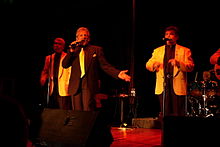Johnny Maestro & the Brooklyn Bridge
| Johnny Maestro & the Brooklyn Bridge | |
|---|---|

Johnny Maestro (center) with Freddy Ferrara (left) and Les Cauchi (right) of the Brooklyn Bridge at a 2006 show
|
|
| Background information | |
| Also known as | The Brooklyn Bridge |
| Origin | New York City, U.S. |
| Genres | Doo wop, R&B, pop, rock |
| Years active | 1968–2010 |
| Labels | Buddah, Collectables |
| Associated acts | The Del-Satins, The Crests |
| Members |
Lead Vocals Joe Esposito Background Vocals Les Cauchi Keyboards Marty D'Amico Guitar Jim Sarle Bass Guitar Jimmy Rosica Drums Lou Agiesta Saxophone Joe Ruvio Sound Engineer "Smitty" Edward Smith |
| Past members |
Lead Vocals Johnny Maestro Roy Michaels Music Director Tom Sullivan Background Vocals Mike Gregorio Freddie Ferrara Keyboards Carolyn Wood Guitar Richie Macioce Ed Lisciandro Trumpet Shelly Davis Drums Artie Cantanzarita Drums Tony Trombino |
Johnny Maestro & the Brooklyn Bridge (known as The Brooklyn Bridge Band since 2010) is an American musical group, best known for their million-selling rendition of Jimmy Webb's "The Worst That Could Happen" (1968).
New York City-born Johnny Maestro (born John Mastrangelo aka Johnny Mastro, Johnny Masters; May 7, 1939 – March 24, 2010) began his career in 1957 as the original lead singer of The Crests, one of the first interracial groups of the recording industry. Patricia Van Dross, older sister to famed R&B singer Luther Vandross, sang with Johnny Maestro while The Crests were signed to the Joyce Record label. Before The Crests signed with Coed Records, Patricia left the group because her mother didn't want her 15-year-old daughter touring with the older guys. After a regional hit with "My Juanita"/"Sweetest One" on the Joyce label, he had three years of chart success with The Crests on Coed Records with "16 Candles", "Six Nights A Week", "Step by Step", "The Angels Listened In", and "Trouble in Paradise". Between "Step by Step" and "Trouble in Paradise", Coed released a single "The Great Physician"/"Say It Isn't So" under the name Johnny Masters. Late in 1960, Maestro would leave The Crests for a solo career. Maestro was unable to reach his former chart heights with The Crests, but did have Top 40 hits with "What A Surprise" and "Model Girl" in 1961 as solo artist Johnny Mastro, "The Voice of the Crests" for Coed Records. For his next three singles with the label, he was known as Johnny Maestro, the third spelling change for the label. None of those records charted and Maestro recorded for three different labels before recording with new backup singers (none from the original group) as Johnny Maestro & The Crests in 1965 and 1966, which produced four singles on two more labels.
By 1967, another New York vocal group called The Del-Satins—who had become well known in the New York area as weekly performers on the local dance party program The Clay Cole Show, had made several non-charting recordings between 1959 and 1967 under their own name, and were also noted for backing up Dion on his post-Belmonts recordings—were looking for a new lead singer to replace original lead Stan Zizka. Other members were brothers Fred and Tom Ferrara (baritone and bass), Les Cauchi (first tenor) and Bobby Faila (second tenor). According to Cauchi, members of the group ran into Maestro at a local gym, playing his guitar, and approached him with the offer to join the group. After initially turning them down, Maestro's manager, Betty Sperber, called Cauchi and told him Maestro had changed his mind.
...
Wikipedia
